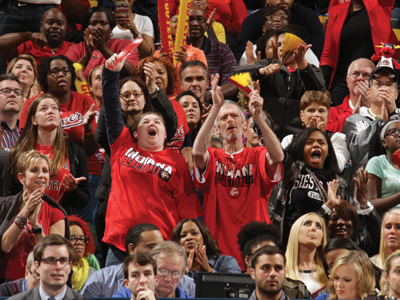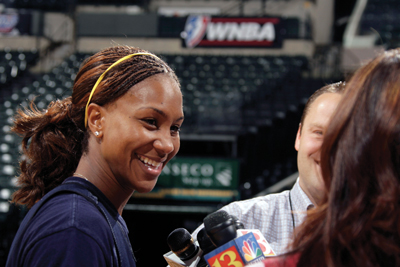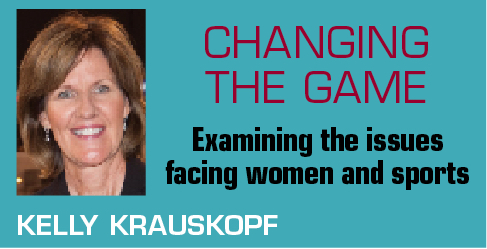Indiana Fever President and General Manager Kelly Krauskopf has been with the club since its inception in 1999, but her work with the WNBA goes back to the league’s founding and its inaugural season in 1997. Krauskopf spoke recently with SportsBusiness Journal/Daily Executive Editor Abraham Madkour about the changes she’s seen in women’s sports as well as the opportunities that still exist, including potential gains through fantasy sports.
■ On the development of the WNBA’s female fan base: I was with the league in the beginning and those early years, really when we kicked the season off, [it] was so much about the support of women. It was as if the women fans that we had at the time were supporting the league for the sheer purpose of being connected to the significance of a women’s pro league finally in the sport of basketball. It felt like there was this cause behind it. The numbers of women that showed up in these arenas all over the country: many of them had never been season-ticket holders. A lot of them hadn’t been to many basketball games. They really showed their support because it was a passion to support women in the sports industry and league.
 |
Audiences at WNBA games have become more evenly split between men and women.
Photo by: NBAE / GETTY IMAGES
|
Now coming up on year 20, there is an opportunity to go back to potentially that type of mission or relevance to women and what the league stands for. We have had a flip in terms of numbers of men that now support the sport or [are] watching. That is a great thing. I do think women are multidimensional people: They are mothers and working executives. We have talked a lot about the platforms that we do in our leagues — like our Inspiring Women platform, where we recognize women in our communities [who] do great things. There are all kinds of marketing initiatives that you can do. You have to be very strategic about how we are going to talk to the women’s fan base. The traditional ways of talking and reaching a particular segment has significantly changed.
■ The audience split at WNBA games: Overall, it is about 47 percent women, so you are looking at about 53 percent guys. When we started, we were 65 percent women in the building. It was unbelievable. As we have gone through the years and have leveled off, a lot of the male sports fans that have started replacing the women tell us through our research that their wife is the one that got them there. Now they are the ticket holder and invested in the game because they are the sport’s fans.
I think that is a respectable fan base. I think the key is we want to engage that fan base in a more meaningful way. One of my passions and one of the things that I have thought about … is story telling and connections. You really can galvanize a fan base through connection. We have to continue to tell stories of these players. If you do not know who you are watching, you are not invested in the outcome and the athlete. Our story telling, whether we have to do it ourselves because we are not getting much help from earned media, is something that we can continue to establish and build on.
 |
Tamika Catchings and the Fever drew more media attention in 2009 at the WNBA Finals.
Photo by: NBAE / GETTY IMAGES |
■ On the WNBA being marketed as a cause as opposed to a top-level sport: We can thrive as both of those. If you look back at the launch of the league, the women [who] showed their support were pre-Title IX women because they never got the opportunity to play. They were younger women because they saw the dream of being a pro player finally being reality. The league represented something bigger than the sport itself. Women identified with that significance. Marketers love that emotional connection. When there is an emotional connection to your brand and products, if that is cause-driven, that is fine. That is how we delivered all the female customers back in the 1997, ’98, ’99 seasons. In some ways we should embrace that. We are the only women’s pro sports league in America that has been around for coming up on 20 years. We should embrace that unique selling position. I do not think that it has to take away from the competitive aspect.
■ On mainstream media coverage of women’s sports: There have been some positive steps. … I have seen some changes and some traction and I think, honestly, it is because 435,000 girls play the sport of basketball, and in another 20 years, the numbers are going to keep coming. It is not going away. The opportunities and storylines of what is happening out there are going to continue to grow.
Tips for career development
■ Advice for young women who want to get into the executive ranks of sports: Get in anywhere you can, at any level. It is such a competitive field now and different from when I came through. I think taking risks and jumping out and into the data areas; I think you have to be very close to the … team finances. Understanding really the business side, being involved in the budgeting process and being involved in all your team’s finances is really a key area. It is our responsibility to continue to cultivate leaders and young women. There are opportunities out there for all of us to understand what our role is in helping women lead women down that path.
■ A characteristic, skill set or attribute she looks for when interviewing a young person: I like to find out how they think. I don’t know if that makes sense or not. When I have a conversation, it could be something about problem-solving. It could be around decision-making. A passion for being here. Often times you get young people that say they just want to work in sports. That is always a tough one. Young people who have come through here that have said that have floundered around and there has been lack of clarity. It is more about being able to articulate how you problem-solve, how you approach your decision-making, and some organizational skills. We can teach and lead some of the finer aspects of our businesses.
■ On the connection of mainstream media coverage and corporate support: There would be more corporate support if there was more coverage in mainstream media. … Let’s face it: The media tells people what is important. We have seen it in our own market. When we were in the Finals in 2009, the mainstream media, not just the sports guys that covered us, were telling everyone in our city just by talking about it. That was important. All of a sudden, you need to be there and the profiles have been raised. There was a direct result of impact from that. That is carried through to where we are today. ...
Unlike a lot of startup men’s leagues, our league has encountered a lot of societal and cultural scrutiny on really the value of women athletes and women as professional athletes. Not only are you a startup sports league, you are also fighting and navigating through this scrutiny of where you sit. Part of that is media coverage. When you get a little bit of media coverage, there is all of a sudden more value to be placed on you. We know that it is true. We know that all of a sudden your corporate partners are going, “Hey, I think I read a little about Tamika Catchings the other day. What other opportunities do we have? I want to make sure we are with you guys.”
The other thing that I will say that could be transformational for us is fantasy sports. Because it causes you to really obviously get to know your players and teams … it really creates the top fan engagement that we are talking about. …
I was in New York [late last year] for the board of governors board meeting. I was watching the Pacers play the Warriors … sitting next to a couple guys in a restaurant where I was watching the game. We started talking about the WNBA. He was from Golden State. Two of them go, “Why doesn’t the WNBA have fantasy sports? We don’t have a team in the Golden State area, but if you had fantasy sports, we would play. I would dig up all the research on your players. I think I know some of the names.”
He has probably been in the past five to six months the 10th person to say that. Literally, I am not asking for the question; it just came to us. We have talked about it as leaders of our teams about the fan engagement and investing in the outcome of games and really getting to know the players. That creates a stronger fan connection.
Kelly Krauskopf can be reached at kkrauskopf@feverbasketball.com. She was featured as part of SportsBusiness Journal’s annual Game Changers presentation in 2013.






